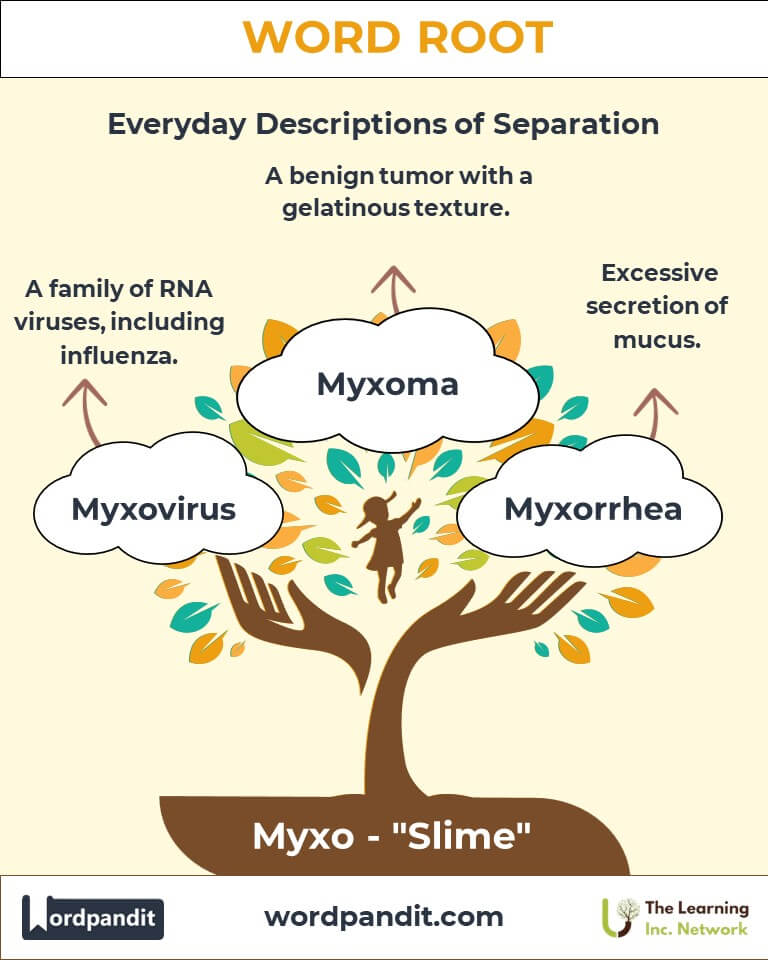Myxo: The Slimy Connection in Language and Science
Discover the fascinating world of "Myxo," a root from Greek meaning "slime." Found in words like myxoma and myxomycete, this root reveals intriguing insights into biology, medicine, and even linguistics.

Table of Contents
- Introduction: The Essence of Myxo
- Etymology and Historical Journey
- Mnemonic: Unlocking the Power of Myxo
- Common Myxo-Related Terms
- Myxo Through Time
- Myxo in Specialized Fields
- Illustrative Story: Myxo in Action
- Cultural Significance of the Myxo Root
- The Myxo Family Tree
- FAQs about the Myxo Word Root
- Test Your Knowledge: Myxo Word Root Quiz
- Conclusion: The Living Legacy of Myxo
Introduction: The Essence of Myxo
Have you ever marveled at the intricate beauty of slime molds or encountered terms like myxoma in medical discussions? The word root "Myxo" (pronounced MIK-soh) comes from the Greek word for slime. Though its meaning might seem simple, its applications span diverse fields such as biology, pathology, and taxonomy, reflecting its importance in understanding both life’s wonders and its challenges.

Etymology and Historical Journey
"Myxo" originates from the Greek word myxa, which translates to slime or mucus. This root was historically used to describe natural substances with viscous qualities. Over time, "Myxo" became integrated into scientific terminologies to denote characteristics associated with slime, including the naming of organisms like slime molds and describing certain pathological conditions.
Mnemonic: Unlocking the Power of Myxo
To remember the root "Myxo," visualize a sticky blob of slime with letters spelling "MYXO" oozing out. This image captures the essence of the root—fluid, transformative, and foundational to various scientific terms.
Mnemonic Device: “Myxo is sticky, slimy, and scientific!”
Common Myxo-Related Terms
-
Myxoma (mik-SOH-muh):
- Definition: A benign tumor composed of gelatinous connective tissue.
- Example: "The patient underwent surgery to remove a myxoma from the heart."
-
Myxomycete (mik-SOH-my-seet):
- Definition: A slime mold, an organism classified under the kingdom Protista.
- Example: "Myxomycetes thrive in damp forest environments, where they help decompose organic matter."
-
Myxovirus (mik-SOH-vahy-ruhs):
- Definition: A family of RNA viruses, including those that cause influenza.
- Example: "Myxoviruses are responsible for the annual flu season."
-
Myxopapilloma (mik-SOH-pap-ih-LOH-muh):
- Definition: A type of benign tumor with a slimy appearance.
- Example: "Myxopapillomas are rare but can occur in glandular tissues."
-
Myxorrhea (mik-SOH-ree-uh):
- Definition: Excessive secretion of mucus.
- Example: "Chronic sinus infections often lead to myxorrhea."
Myxo Through Time
- Myxomycetes: Initially misunderstood as fungi, slime molds (myxomycetes) were later classified under protists, illustrating the complexity of life’s classification systems.
- Myxoma: Historically identified in heart surgery patients, the study of myxomas advanced medical understanding of benign tumors and their treatments.
Myxo in Specialized Fields
-
Medicine:
- Myxoma: Vital in diagnosing benign tumors, particularly in cardiac and soft tissues.
- Myxovirus: Central to understanding and combating viral diseases like influenza.
-
Biology:
- Myxomycete: Essential in ecological studies for nutrient cycling and understanding life cycles involving cellular transformation.
-
Pathology:
- Terms like myxorrhea and myxopapilloma are critical in diagnosing and managing mucosal and glandular disorders.
Illustrative Story: Myxo in Action
Dr. Elena, a renowned mycologist, was on a mission to study myxomycetes in the Amazon rainforest. As she observed a slime mold creeping across a decaying log, she marveled at its ability to move and thrive in such an environment. Back in her lab, her findings helped advance understanding of nutrient recycling in ecosystems. Meanwhile, her colleague, a cardiologist, treated a patient with a myxoma, relying on imaging techniques inspired by biological studies of slimy structures. Together, their work highlighted the scientific importance of "Myxo."
Cultural Significance of the Myxo Root
The concept of slime has fascinated cultures for centuries, from mythical depictions of primordial ooze as the source of life to modern science fiction, where sentient slime often plays a role. In medicine and biology, "Myxo" underscores the interconnectedness of life forms, from microscopic molds to complex human tissues.

The Myxo Family Tree
-
Muco- (Latin: mucus):
- Example: Mucosal (relating to mucous membranes).
-
Gel- (Latin: gel-like):
- Example: Gelatinous (jelly-like consistency).
-
Phyco- (Greek: algae or seaweed):
- Example: Phycology (the study of algae).

FAQs About " Myxo "
Q: What does "Myxo" mean?
A: "Myxo" means slime or mucus, originating from the Greek word myxa. This root is commonly used in scientific terminology to describe organisms, substances, or conditions that have a slimy or mucous-like quality.
Q: What is a myxoma?
A: A myxoma is a benign tumor made up of gelatinous connective tissue. It is most commonly found in the heart, where it can obstruct blood flow. The term highlights the tumor's slimy, jelly-like consistency, which mirrors the root's meaning.
Q: What are myxomycetes?
A: Myxomycetes are a group of slime molds classified as protists. They are fascinating organisms that exhibit characteristics of both fungi and amoebas, playing a critical role in ecosystems by breaking down organic material.
Q: What is a myxovirus?
A: Myxoviruses are a family of RNA viruses that include influenza viruses. The term "Myxo" was chosen because these viruses interact with mucosal surfaces, especially in the respiratory tract.
Q: How does "Myxo" relate to medicine?
A: In medicine, "Myxo" is used to describe various conditions or structures that involve mucus or slime-like substances. For example, myxomas are gelatinous tumors, and myxorrhea refers to excessive mucus secretion.
Q: Why are myxomycetes important in biology?
A: Myxomycetes are important because they decompose dead plant material, recycling nutrients back into the ecosystem. Their ability to transition between single-celled and multicellular forms also provides valuable insights into evolutionary biology.
Q: What is myxorrhea?
A: Myxorrhea refers to an abnormal or excessive secretion of mucus. This condition is often associated with chronic infections or inflammations of mucosal surfaces, such as in the sinuses or respiratory tract.
Q: Can myxoviruses cause serious diseases?
A: Yes, myxoviruses can cause serious illnesses, particularly the influenza virus, which leads to widespread respiratory infections. Some strains have been responsible for pandemics.
Q: What is the significance of the "Myxo" root in taxonomy?
A: In taxonomy, "Myxo" helps categorize organisms that produce or resemble slime, such as slime molds (myxomycetes). It highlights key physical or functional traits that aid in scientific classification.
Q: How do myxomycetes differ from fungi?
A: Although myxomycetes resemble fungi, they are not classified as such. Unlike fungi, they lack a rigid cell wall made of chitin and exhibit a life cycle that includes a motile, amoeba-like stage, distinguishing them as protists.
Test Your Knowledge: " Myxo " Mastery Quiz
1. What does the root "Myxo" signify?
2. Which organism is a myxomycete?
3. What does "myxorrhea" describe?
4. What family of viruses includes myxoviruses?
5. What field studies myxomycetes?
Conclusion: The Living Legacy of Myxo
The root "Myxo" highlights the significance of slime, from its role in ecosystems to its implications in health and disease. Its adaptability across disciplines reflects its enduring relevance. As science continues to explore the slimy aspects of life, "Myxo" will remain a vital linguistic and conceptual tool, bridging biology, medicine, and culture.












